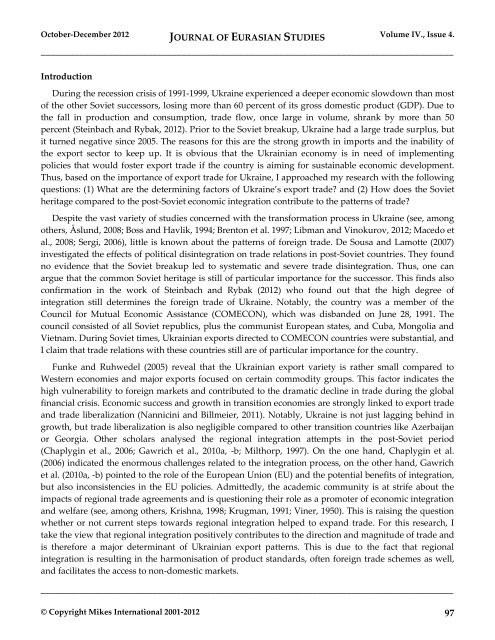You also want an ePaper? Increase the reach of your titles
YUMPU automatically turns print PDFs into web optimized ePapers that Google loves.
October-December 2012 JOURNAL OF EURASIAN STUDIES Volume IV., Issue 4.<br />
_____________________________________________________________________________________<br />
Introduction<br />
During the recession crisis <strong>of</strong> 1991-1999, Ukraine experienced a deeper economic slowdown than most<br />
<strong>of</strong> the other Soviet successors, losing more than 60 percent <strong>of</strong> its gross domestic product (GDP). Due to<br />
the fall in production and consumption, trade flow, once large in volume, shrank by more than 50<br />
percent (Steinbach and Rybak, 2012). Prior to the Soviet breakup, Ukraine had a large trade surplus, but<br />
it turned negative since 2005. The reasons for this are the strong growth in imports and the inability <strong>of</strong><br />
the export sector to keep up. It is obvious that the Ukrainian economy is in need <strong>of</strong> implementing<br />
policies that would foster export trade if the country is aiming for sustainable economic development.<br />
Thus, based on the importance <strong>of</strong> export trade for Ukraine, I approached my research with the following<br />
questions: (1) What are the determining factors <strong>of</strong> Ukraine’s export trade? and (2) How does the Soviet<br />
heritage compared to the post-Soviet economic integration contribute to the patterns <strong>of</strong> trade?<br />
Despite the vast variety <strong>of</strong> studies concerned with the transformation process in Ukraine (see, among<br />
others, Åslund, 2008; Boss and Havlik, 1994; Brenton et al. 1997; Libman and Vinokurov, 2012; Macedo et<br />
al., 2008; Sergi, 2006), little is known about the patterns <strong>of</strong> foreign trade. De Sousa and Lamotte (2007)<br />
investigated the effects <strong>of</strong> political disintegration on trade relations in post-Soviet countries. They found<br />
no evidence that the Soviet breakup led to systematic and severe trade disintegration. Thus, one can<br />
argue that the common Soviet heritage is still <strong>of</strong> particular importance for the successor. This finds also<br />
confirmation in the work <strong>of</strong> Steinbach and Rybak (2012) who found out that the high degree <strong>of</strong><br />
integration still determines the foreign trade <strong>of</strong> Ukraine. Notably, the country was a member <strong>of</strong> the<br />
Council for Mutual Economic Assistance (COMECON), which was disbanded on June 28, 1991. The<br />
council consisted <strong>of</strong> all Soviet republics, plus the communist European states, and Cuba, Mongolia and<br />
Vietnam. During Soviet times, Ukrainian exports directed to COMECON countries were substantial, and<br />
I claim that trade relations with these countries still are <strong>of</strong> particular importance for the country.<br />
Funke and Ruhwedel (2005) reveal that the Ukrainian export variety is rather small compared to<br />
Western economies and major exports focused on certain commodity groups. This factor indicates the<br />
high vulnerability to foreign markets and contributed to the dramatic decline in trade during the global<br />
financial crisis. Economic success and growth in transition economies are strongly linked to export trade<br />
and trade liberalization (Nannicini and Billmeier, 2011). Notably, Ukraine is not just lagging behind in<br />
growth, but trade liberalization is also negligible compared to other transition countries like Azerbaijan<br />
or Georgia. Other scholars analysed the regional integration attempts in the post-Soviet period<br />
(Chaplygin et al., 2006; Gawrich et al., 2010a, -b; Milthorp, 1997). On the one hand, Chaplygin et al.<br />
(2006) indicated the enormous challenges related to the integration process, on the other hand, Gawrich<br />
et al. (2010a, -b) pointed to the role <strong>of</strong> the European Union (EU) and the potential benefits <strong>of</strong> integration,<br />
but also inconsistencies in the EU policies. Admittedly, the academic community is at strife about the<br />
impacts <strong>of</strong> regional trade agreements and is questioning their role as a promoter <strong>of</strong> economic integration<br />
and welfare (see, among others, Krishna, 1998; Krugman, 1991; Viner, 1950). This is raising the question<br />
whether or not current steps towards regional integration helped to expand trade. For this research, I<br />
take the view that regional integration positively contributes to the direction and magnitude <strong>of</strong> trade and<br />
is therefore a major determinant <strong>of</strong> Ukrainian export patterns. This is due to the fact that regional<br />
integration is resulting in the harmonisation <strong>of</strong> product standards, <strong>of</strong>ten foreign trade schemes as well,<br />
and facilitates the access to non-domestic markets.<br />
_____________________________________________________________________________________<br />
© Copyright Mikes International 2001-2012 97

















